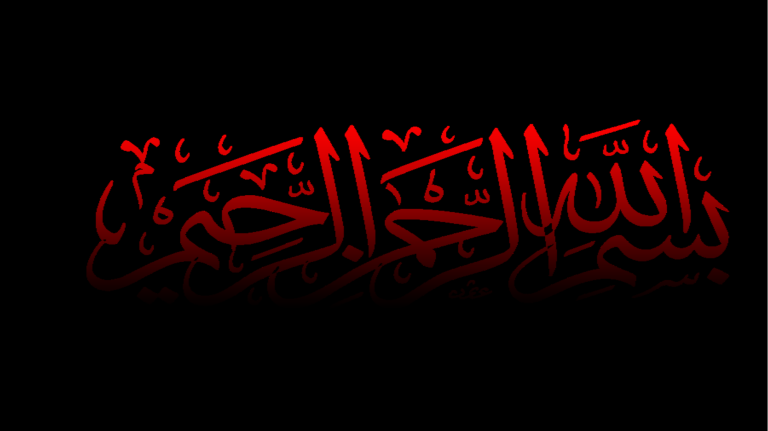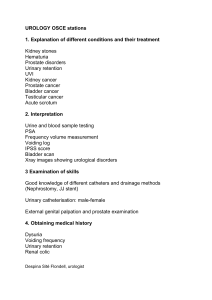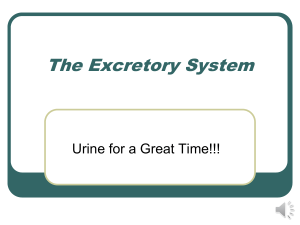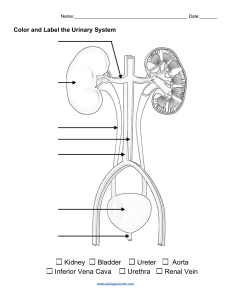
RENAL SYSTEM BSMIT-F18-098 BSMIT-F18-122 BSMIT-F18-126 BSMIT-F18-127 BSMIT-F18-129 BSMIT-F18-130 BSMIT-F18-146 BSMIT-F18-170 ANATOMY OF KIDNEY Definition: Kidney a re a pair of excretory organ that’s remove waste products, except of water and salt from the blood and maintain its pH. Also called renes derived from renal. Location: Saturated on the posterior abdominal wall on each side of the vertebral column behind the peritoneum Extend from upper border of 12th vertebra to the centre of the body of 3rd lumber vertebra. Shape and size: o Bean shaped o Reddish brown in colour EXTERNAL FEATURES Two poles of the kidney: The upper pole is broad and is in close contact with the corresponding suprarenal gland The lower pole is pointed . Two surfaces: The interior surface is said to be irregular and the posterior surface is flat. Two border: The lateral border is convex. The medial border is concave. Its middle part show s depression, the hilus or hilum. STRUCTURE OF KIDNEY Naked eye examination of a coronal section of the kidney shows An outer, reddish brown cortex An inner, pale medulla A space, the renal sinus CAPSULE OR COVERING OF KIDNEY Renal Fascia: Outer layer dense fibrous bind kidney to abdominal wall Perirenal Fat Capsule: Thick layer of adipose tissue lying outside the fibrous capsule It is thickest at the border of the kidney and fill up the extra space in the renal sinus Fibrous Capsule: This is a thin membrane which closely invests the kidney and lines the renal sinus Normally it can be easily stripped off from the kidney ANATOMY OF URINARY BLADDER Urinary bladder is the temporary store house of urine which gets emptied through the urethra Size Shape and Position : The bladder varies in its size,shape and position according to the amount of urine it contains When empty it lies entirely with in the pelvis but as it fill it expands and extends into upwards into the abdominal cavity reaching up to the umbilicus or ever higher External features: An empty bladder is tetrahedral in shape and has: Apex, base or fundus and neck Three surfaces and four borders Continued… Full bladder is ovoid in shape and has: An apex, a neck and 2 surfaces Layers Of Bladder: • Outer Layer (Loose connective tissue) • Middle Layer (Smooth muscles and elastic fibres) • Inner Layer (Lined with transitional epithelium) RENAL STONE A stone in the kidney lower down in the urinary tract also called kidney stone The process of stone formation is called nephrolithiasis or urolithiasis. Types : • About 80% are composed of either calcium oxalate or calcium oxalate mixed with calcium phosphate • About 10% are composed of magnesium ammonium phosphate . • Approximately 6% to 9% are either uric acid or cystine stone SIGNS AND SYMPTOMS Severe pain in the sides and back below the ribs Pain or urination. Pink, red or brown urine. Nausea and vomiting. Cloudy and foul smelling urine. ETIOLOGY OF RENAL STONE Lack of water Diet Obesity Medical condition such as crohn’s disease, urinary tract infection, renal tubular acidosis and hyperparathyroidism increase the risk of kidney stone COMPLICATIONS OF RENAL STONE Abscess Formation Urinary Fistula Formation Ureteral scarring and stenosis Urethral perforation Urosepsis RENAL CYST Renal cyst are sacs of fluid that form in the kidneys They are usually characterized as simple cyst meaning they have a thin wall and contain water like fluid TYPES: • Simple cyst • Polycystic kidney disease SIGNS AND SYMPTOMS • Fever • Pain in your upper abdomen • Swelling of abdomen • Urinating more often than usual • Blood in urine • Dark urine ETIOLOGY OF RENAL CYST There is no main causes of renal cyst Kidney has about a million tiny tubules that collect urine cyst may start to grow when a tube becomes blocked, swell up and fills with fluid You are more likely to have kidney cyst as you get older Polycystic kidney disease is an inherited condition meaning its caused by changes genes that are passed down through families. COMPLICATIONS OF RENAL CYST Infection in the cyst Burst cyst Blockage of urine out of the kidney High blood pressure URINARY TRACT OBSTRUCTION It is when your urine cant flow through your ureter,bladder or urethra due to some type of obstruction Instead of flowing from your kidneys to your bladder,urine flows backward or refluxes,into your kidneys The ureters are two tubes that carry urine from each kidneys to bladder It increase suspectibility to infection and to stone formation Unrelieved obstruction almost always leads to permanent renal atrophy SITES OF OBSTRUCTION • Kidneys • Ureter • Bladder • Prostate • Urethra SIGNS AND SYMPTOMS • Inability to pass urine • Weak stream of urine • Interrupted stream • Blood in urine • Pain in either flank or in the back • Abdominal pain • Swelling • A frequent urge to urinate,especially at night • The feeling that your bladder is not empty COMMON CAUSES • Prostate Enlargement • • Stones • Tumor • Abnormal congenital structures • Infection • • Blood clots Abnormal tissue that results from instrumentation of the urinary tract • Enlarge uterus in pregnant women • Foreign body • Trauma with pelvic fracture Weak bladder that can not pus the uterine out Diagrams Of Urinary Tract Obstruction X-RAY AND ULTRASOUND OF UTO TREATMENT These include: • Surgery • Stent placement • Treatment for unborn children (Doctor may place a shunt, or drainage system, in unborn baby bladder and the shunt will drain urine into the amniotic sac) RENAL CELL CARCINOMA It is a kidney cancer that originates in the lining of the proximal convoluted tubule, a part of very small tubes in the kidney that transport primary urine It is considered as adenocarcinoma It may be sporadic and heredity It is mainly associated with the mutations in short arm of chromosome 3 RISK FACTORS • Smoking • Obesity • Hypertension • Long term use of NSAIDS • Genetics SIGNS AND SYMPTOMS It includes: • Hematuria • Weight loss • Flank pain • Hypertension • Abdominal mass • Hypercalcemia • Anemia • Night sweats • Loss of appetite • Fatigue SITES OF RCC The most common sites are: • Lymph nodes • Lungs • Bones • Liver • Brain TREATMENT OF RCC Surgery Radiotherapy Chemotherapy Immunotherapy Targeted therapy TRANSITIONAL CELL CARCINOMA TCC arise from the transitional epithelium, a tissue lining the inner surface of these hollow organs It is the most common type of bladder cancer and the cancer of ureter and urethra SIGNS AND SYMPTOMS Blood in urine Pain in the back that does not go away Extreme tiredness Weight loss with no known reason Painful or frequent urination CAUSES OF TCC TCC is less common than other kidney or bladder cancers.The causes of disease have not been fully identified.Genetic factors have been noted to cause the disease in some patients • Abuse of phenacentin • Working in the chemical or plastic industry • Exposure to coal and tar • Use of cancer treating drugs SITES OF TCC o Pelvic lymph nodes o Visceral sites a. Lungs b. Liver c. Bones o Brain (Especially after systemic chemotherapy) TREATMENT OF TCC • Laser surgery or Endoscopic resection • Segmental resection • Nephroureterectomy Doctors may also used other treatments to make sure the cancer does not come back • Chemotherapy • Anticancer drugs • Biological therapies ANATOMY OF PROSTATE The prostate is a gland of male body that adds part of the fluid to semen A healthy human prostate is slightly larger than walnut It surrounds the urethra just below the urinary bladder The prostate lies in the pelvis, below the neck of the urinary bladder, behind the lower part of pubic symphysis and the upper part of pubic arch It lies in front of the ampulla of the rectum 4cm transversely at the base width, 3cm vertically length, 2cm anterioposteriorly thickness and weight about 8g GROSS FEATURES APEX: o The apex is directed downward surrounds the junction of prostatic and membranous parts of posterior urethra BASE: o The base is directed upwards and is structurally continuous with neck of bladder o It has four surfaces: i. Anterior ii. Posterior iii. 2 inferolateral ZONES OF PROSTATE The prostate has been described as consisting of 3 zones or 4 zones Peripheral zone: Fraction of adult gland is 70% Central zone Fraction of adult gland is 20% Transition zone Fraction of adult gland is 5% LOBES OF PROSTATE It is incompletely divided into 5 lobes: • Anterior Lobe: Roughly corresponds to part of the transitional zone • Posterior Lobe: Roughly corresponds to peripheral zone • Right and Left Lateral Lobe: Span all zones • Median Lobe (Middle Lobe) Roughly correspond to part of central zone BENIGN PROSTATIC HYPERPLASIA Enlargement of the prostate is called benign prostatic hyperplasia (BPH) It occurs when the cells of the prostate gland begin to multiply These additional cells cause your prostate gland to swell which squeezes the urethra and limits the flow of urine BPH is not the same as prostate cancer and does not increase the risk of cancer BPH is more common in men older than 50 years CAUSES OF BPH Blockage of urine flow The prostate gland is located beneath your bladder the tube that transport urine from the bladder out of urethra passes through the center of the prostate When the prostate enlarges, it begin to block urine flow Cause of prostate enlargement it might be due to changes in the balance of sex hormones as men grow older SIGNS AND SYMPTOMS It include: Frequent or urgent need to urinate Increased frequency of urination at night Difficulty starting urination Weak urine stream or a stream that stops and starts Dribbling at the end of urination Inability to completely empty the bladder COMPLICATIONS OF BPH It include: Sudden inability to urinate Urinary tract infections Bladder stones Bladder damage Kidney damage X-RAY AND ULTRASOUND OF BPH CT-SCAN AND MRI OF BPH MULTICYSTIC DYSPLASTIC KIDNEY The term “Multicystic Renal Dysplasia” or Potter type II is defined as abnormal metanephric differentiation, has variable presentations that cover a spectrum of conditions,including: • Hypoplasia • Multicystic dysplasia and aplasia • Replacement of the renal parenchyma by multiple cysts and non functioning dysplastic tissue CAUSES OF RENAL DYSPLASIA Multicystic dysplastic kidney has been reported in various syndromes, including the following: 49,XXXXX syndrome o Beckwith-Wiedemann Syndrome Hypoparathyrodism –deafness-renal syndrome o Williams Syndrome Mental retardation SIGNS AND SYMPTOMS It includes: Hydronephrosis Ureteropelvic junction obstruction Ureterovesical junction obstruction DIAGNOSIS • Urine analysis • Biochemical Investigation • Imaging studies • Renal ultrasonography (Ultrasonography reveals a kidney that contains multiple cysts of variable size that are randomly arranged and are separated by little or no echogenic parenchyma)






